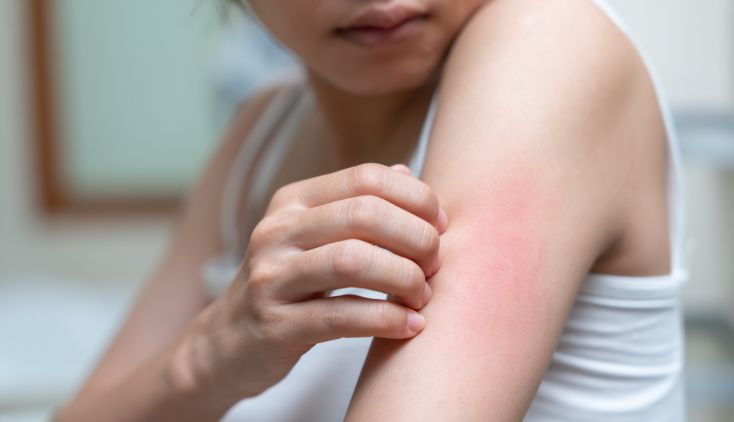Understanding Common Skin Rashes and Their Causes
Skin rashes are common conditions that affect the skin’s comfort and integrity. These rashes can range from mildly irritating to severely problematic. Understanding the causes of different types of skin rashes can help with prevention and treatment. In this article we review some of the most common types of skin rashes and why they appear.
1. Contact Dermatitis
Contact dermatitis occurs when the skin comes into direct contact with an irritant or allergen, resulting in a rash that is red and itchy with small bumps or blisters. Common triggers include:
- Sensitivity to certain soaps and detergents.
- Hair dye, cosmetics and skincare products.
- Jewelry and belt buckles containing nickel.
- Poison ivy, oak or sumac.
- Latex allergies.
- Pesticides, preservatives, industrial chemicals and more.
To treat contact dermatitis, it is important to identify the trigger for the reaction and avoid it. Itching and redness can be controlled by using over-the-counter corticosteroid creams to reduce inflammation.
2. Eczema
Eczema is a long-term form of dermatitis that tends to flare periodically. An eczema outbreak is characterized by dry, itchy skin with red patches that may ooze or crust over. The affected skin may appear red and raw from scratching.
Eczema can occur anywhere on the body but most commonly occurs in the creases of elbows and knees.
Common causes and triggers include:
- Genetic factors, such as a family history of allergies and asthma.
- Immune system dysfunction.
- Environmental triggers, like cold air, sudden temperature changes, allergens or irritants.
- Emotional stress.
Those with eczema should identify and avoid triggers that may worsen their condition, such as allergens and irritants. Treatment typically involves moisturizing regularly, taking antihistamines and using topical steroids or other prescribed medication when necessary.
3. Psoriasis
Psoriasis is a long-term genetic condition where skin cells multiply much faster than normal. It is theorized that psoriasis is an immune disorder. The conditions appear as patchy rashes that may scale, dry, crack and bleed, leading to itchy and/or painful skin. The rash may come and go, with outbreaks lasting for weeks or months, and can be triggered by a variety of factors. Triggers include:
- Cold weather conditions.
- Heavy alcohol use.
- Strep throat.
- Skin infections or injuries caused by cuts, scrapes, bug bites or sunburn.
- Prescription medications like lithium or blood pressure treatments.
- Corticosteroid withdrawal.
Treatment options range from topical treatments, such as corticosteroids, retinoids and salicylic acid, to oral medications and light therapy, depending on severity.
4. Heat Rash
Heat rash, also known as “prickly heat,” occurs when sweat ducts become blocked and trap sweat beneath the skin. It appears as small red bumps or blisters, typically in skin folds or where clothing rubs against the skin, and can be very itchy. Triggers include:
- Hot, humid weather.
- Intense physical activity.
- Tight clothing.
- Fever.
- Prolonged bed rest.
Cooling the skin with air conditioning or a cool shower, wearing loose and breathable clothing and keeping affected areas dry can help relieve symptoms. Anti-itch creams can be used if the itching becomes problematic.
5. Hives (Urticaria)
Hives are raised, itchy welts that can appear suddenly and are often a symptom of an allergic reaction. These itchy welts can appear anywhere on the body and often change location or shape. Hives turn white when pressed, which helps to diagnose the condition. Triggers include:
- Food allergies (especially to nuts, shellfish, eggs and dairy).
- Medication reactions.
- Insect bites or stings.
- Pet dander, pollen, latex or other common allergens.
- Infections like urinary tract infections or strep throat.
- Physical triggers like sudden changes in temperatures, pressure, exercise or sun exposure.
Treatment typically involves antihistamines and identifying and avoiding triggers.
6. Fungal Rashes
Fungal rashes like athlete’s foot, jock itch and ringworm are caused by fungi thriving in warm, moist environments. They can spread through contact with infected people, animals or shared items.
These rashes can be treated with over-the-counter antifungal creams.
7. Viral Rashes
Viral rashes often appear as small red spots that may blister. Several viruses can cause distinctive rashes, including:
- Chickenpox (varicella-zoster virus).
- Measles (rubeola).
- Roseola (human herpesvirus 6).
- Hand, foot and mouth disease.
- Fifth disease (parvovirus B19).
Vaccines currently exist for chickenpox and measles and can be administered at a young age to reduce the risk of catching these viruses. Once infected with a virus, treatment typically focuses on easing symptoms.
When to See a Doctor
While many rashes can be managed at home, certain symptoms warrant medical attention. When a rash does not improve with home treatment, it should be looked at by a professional. Seek medical care for a rash that covers the entire body, is accompanied by a fever or becomes painful and blistered. If the rash swells, is warm to the touch, oozes or has an odor, this could be a sign of an infection and requires urgent medical care.
If you have frequent outbreaks, consider seeing a doctor to request an allergen panel to determine possible triggers. Based on testing, your doctor can come up with a personalized plan to help you avoid triggers in the future, leading to clearer skin.
